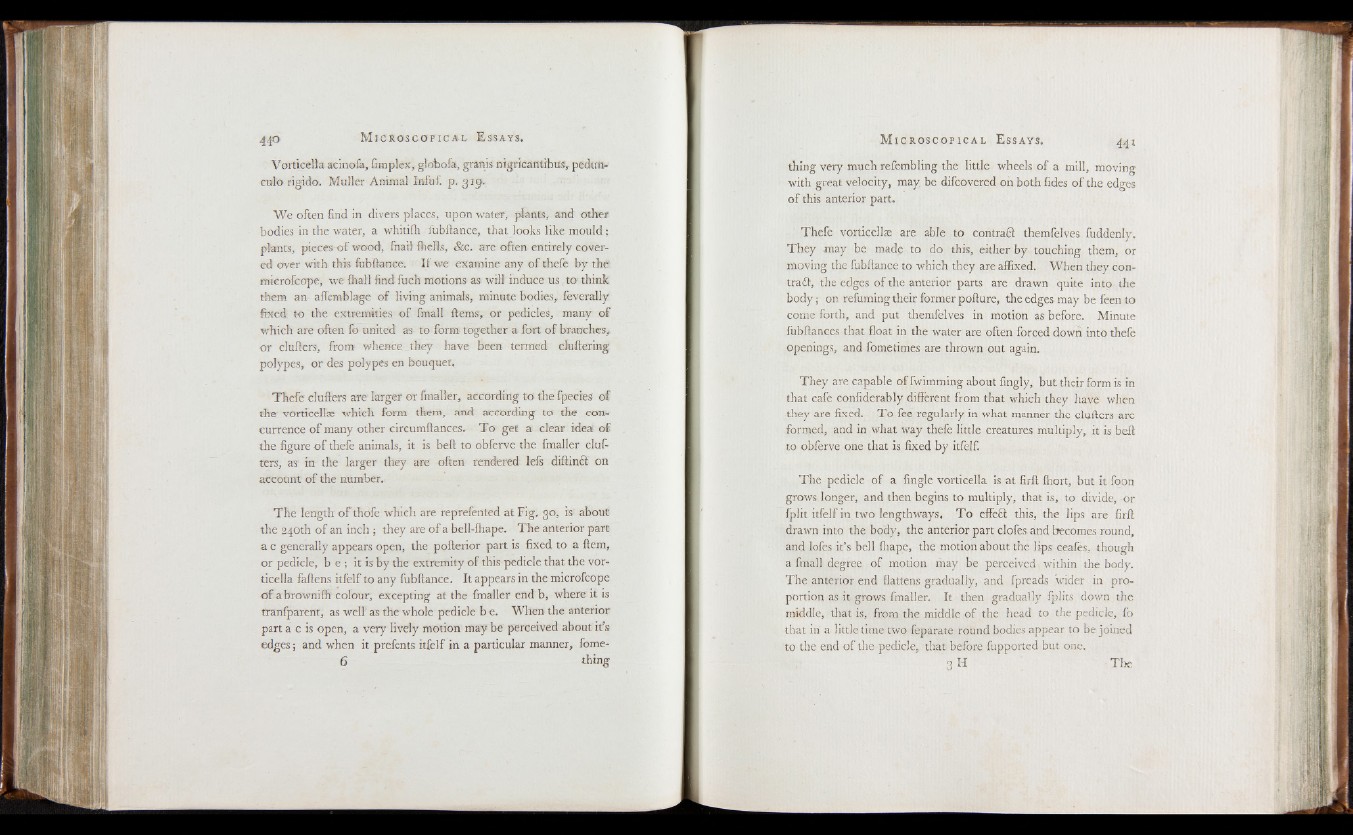
M 44° i c r o s c o p i c a l E ssays .
Vorticella acinofa, fimplex, globofa, granis nigricaHtibus, pedun-
culo rigido. Muller Animal Inful. p. 319.
We often find in divers places, upon water, plants, and other
bodies in the water, a whitilh fubftance, that looks like mould;
plants, pieces o f wood, fnail fhells, &c. are often entirely covered
over with this fubftance. I f we examine any of thefe by the
mierofcope, we [hall find fuch motions as will induce us to think
them an aflemblage o f living animals, minute bodies,, feverally
fixed to the extremities of final! Hans’, or pedicles, many of
which are often fo united as to form together a fort o f branches,
or clufters, from whence they have been termed cl tillering
polypes, or des polypes en bouquet.
Thefe clufters are larger or fmaller, according to the fpecies of
the vorticellae which form them, and according to the concurrence
of many other circumftances. T o get a clear idea of
the figure o f thefe animals, it is bell to obferve the fmaller clufters,
as m the larger they are often rendered lefs diltinct on
account of the number.
The length o f thofe which are reprefented at Fig. go, is about
the 240th of an inch ; they are o f a bell-fhape. The anterior part
a c generally appears open, the pofterior part is fixed to a Item,
or pedicle, b e ; it is by the extremity o f this pedicle that the vorticella
fallens itfelf to any fubftance. It appears in the mierofcope
o f abrownifh colour, excepting at the fmaller endb, where it is
tranfparent, as well as the whole pedicle b e. When the anterior
part a c is open, a very lively motion may be perceived about it’s
edges; and when it prefents itfelf in a particular manner, fome- 6 thing
M i c r o s c o p i c a l E ssays. 441
thing very much refembling the little wheels o f a mill, moving
with great velocity, may be difeovered on both fides o f the edges
o f this anterior part.
Thefe vorticellae are able to contrail themfelves fuddenly.
They may be madg to do this, either by touching them, or
moving the fubftance to which they are affixed. When they con-
tradl, the edges of the anterior parts are drawn quite into the
body; on refuming their former pofture, the edges may be feen to
come forth, and put themfelves in motion as before. Minute
fubftances that float in the water are often forced down into thefe
openings, and fome times are thrown out again.
They are capable of fwimming about fingly, but their form is in
that cafe confiderably different from that which they have when
they are fixed. T o fee regularly in what manner the clufters are
formed, and in what way thefe little creatures multiply, it is bell
to obferve one that is fixed by itfelf.
The pedicle o f a fingle vorticella is at firft fhort, but it fqon
grows longer, and then begins to multiply, that is, to divide, or
fplit itfelf in two lengthways. T o effect this, the lips are firft
drawn into the body, the anterior part clofes and becomes round,
and lofes it’s bell lhape, the motion about the lips ceafes, though
a fmall degree of motion may be perceived within the body.
The anterior end flattens gradually, and fpreads "wider in proportion
as it grows fmaller. It then gradually fplits down the
middle, that is, from the middle o f the head to the pedicle, fo
that in a little time two feparate round bodies appear to be joined
to the end of the pedicle, that before fupported but one.
3 I i The
as